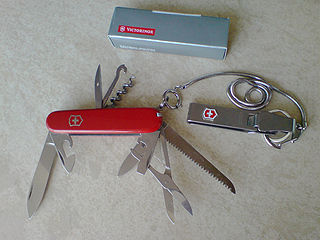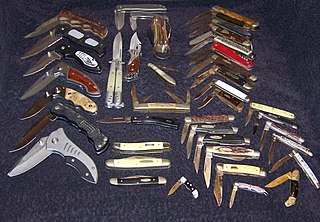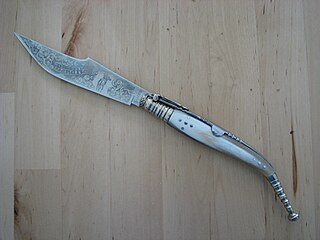The douk-douk is a French-made pocket knife of simple sheet-metal construction. It has been manufactured by the M. C. Cognet cutlery firm in Thiers, France, since 1929.
Contents

The douk-douk is a French-made pocket knife of simple sheet-metal construction. It has been manufactured by the M. C. Cognet cutlery firm in Thiers, France, since 1929.

The external engraving of the douk-douk was created in 1929 by Gaspard Cognet of Cognet, Antoine & Gaspard for sales to France's colonies in Oceania. The handle depicts a "douk-douk", or Melanesian spirit incarnation. Cognet based the design on an engraving in an illustrated dictionary. Later other designs such as the "El Baraka" and "Tiki" were developed for other regional markets, particularly in French Algeria, and even south into Sub-Saharan Africa.
Originally intended as an inexpensive utility pocket knife for the ordinary working man, the popularity of the douk-douk caused it to be pressed into service as a weapon when necessary. [1] During the 1954-1962 FLN-led revolt in Algeria, the douk-douk was used as weapon of assassination and terror; Algerians who ran afoul of the FLN frequently had their noses removed with a knife, many of them douk-douks (or more properly the El Baraka model which was sold in Algeria, due to Muslim ideals on what sorts of images were appropriate). [1] It could easily be converted from a folding-blade pocket knife into a useful fixed-blade knife by the simple expedient of hammering the ends of the sheet-metal handle together behind the blade's bolster, locking the blade into the full-open position.

The douk-douk is a very simple slipjoint knife, having no locking mechanism, but only a very strong backspring to bias it towards the open, closed and 90 degree positions. This intermediate position is to help prevent the blade from snapping shut on the users fingers if the user accidentally folds the blade while cutting. The knife consists of only six parts:
The cutlery firm of M.C. Cognet has continued to produce the knife up to the present day, using the same simple methods. Today they are offered with several decorative designs, stainless or carbon steel blades, in three different sizes.
Current variants

A utility knife is any type of knife used for general manual work purposes. Such knives were originally fixed-blade knives with durable cutting edges suitable for rough work such as cutting cordage, cutting/scraping hides, butchering animals, cleaning fish scales, reshaping timber, and other tasks. Craft knives are small utility knives used as precision-oriented tools for finer, more delicate tasks such as carving and papercutting.

A knife is a tool or weapon with a cutting edge or blade, usually attached to a handle or hilt. One of the earliest tools used by humanity, knives appeared at least 2.5 million years ago, as evidenced by the Oldowan tools. Originally made of wood, bone, and stone, over the centuries, in step with improvements in both metallurgy and manufacturing, knife blades have been made from copper, bronze, iron, steel, ceramic, and titanium. Most modern knives have either fixed or folding blades; blade patterns and styles vary by maker and country of origin.

The Swiss Army knife is a pocketknife, generally multi-tooled, now manufactured by Victorinox. The term "Swiss Army knife" was coined by American soldiers after World War II after they had trouble pronouncing the German word "Offiziersmesser", meaning "officer’s knife".

A blade is the portion of a tool, weapon, or machine with an edge that is designed to puncture, chop, slice or scrape surfaces or materials. Blades are typically made from materials that are harder than those they are to be used on. Historically, humans have made blades from flaking stones such as flint or obsidian, and from various metal such as copper, bronze, and iron. Modern blades are often made of steel or ceramic. Blades are one of humanity's oldest tools, and continue to be used for combat, food preparation, and other purposes.

Leatherman is an American brand of multitools and knives made by Leatherman Tool Group of Portland, Oregon. The company was founded in July 1983 by Timothy S. Leatherman and Steve Berliner in order to market his idea of a capable, easily portable hand tool with multiple functions. That same year, Leatherman sold the first multitool, which was called the PST.

A Japanese kitchen knife is a type of a knife used for food preparation. These knives come in many different varieties and are often made using traditional Japanese blacksmithing techniques. They can be made from stainless steel, or hagane, which is the same kind of steel used to make Japanese swords. Most knives are referred to as hōchō or the variation -bōchō in compound words but can have other names including -kiri. There are four general categories used to distinguish the Japanese knife designs: handle, blade grind, steel, and construction.

A switchblade is a pocketknife with a sliding or pivoting blade contained in the handle which is extended automatically by a spring when a button, lever, or switch on the handle or bolster is activated. Virtually all switchblades incorporate a locking blade, where the blade is locked against accidental closure when the blade is in the open position. It is unlocked by a mechanism that allows the blade to be folded and locked in the closed position.

A pocketknife is a knife with one or more blades that fold into the handle. They are also known as jackknives (jack-knife), folding knives, EDC knife, or may be referred to as a penknife, though a penknife may also be a specific kind of pocketknife. A typical blade length is 5 to 15 centimetres.
A gravity knife is a knife with a blade contained in its handle, and that opens its blade through the force of gravity. This mechanism of opening is fundamentally different from the switchblade, which extends its spring-propelled blade automatically upon the push of a button, switch, or fulcrum lever. The main purpose of gravity opening is that it allows opening and closing to be done one handed, in situations where the other hand is occupied. Hence, historically they have been issued to parachutists to cut off caught lines, such as lines tangled in trees, a major potential use of the gravity knife.

The Opinel company has manufactured and marketed a line of eponymous wooden-handled knives since 1890 from its headquarters in Saint-Jean-de-Maurienne, Savoie, France where the family-run company also operates a museum dedicated to its knives. The company sells approximately 15 million knives annually. Opinel knives are made of both high carbon and stainless steel, the latter being Sandvik steel from Sweden.
The Laguiole knife is a traditional Occitan pocketknife, originally produced in the "knife city" of Thiers, source of 70% of France's cutting tool production, as well as the small village of Laguiole, both located in the Massif central region of France. Laguiole in this instance does not refer to the French knife brand but to a generic type of traditional slipjoint knife associated with this region of France.
In cooking, a chef's knife, also known as a cook's knife, is a cutting tool used in food preparation. The chef's knife was originally designed primarily to slice and disjoint large cuts of beef. Today it is the primary general-utility knife for most Western cooks.
Spyderco is an American cutlery company based in Golden, Colorado, producing knives and knife sharpeners. Spyderco pioneered many features that are now common in folding knives, including the pocket clip, serrations, and the opening hole. Spyderco has collaborated with 30 custom knife makers, athletes, and self-defense instructors for designs and innovated the usage of 20 different blade materials.

A sheath knife is a fixed-bladed knife that fits in a sheath of leather or other material such as nylon or kevlar. The sheath is used to protect the knife and act as a carrier. Most importantly, the sheath protects the person carrying the knife from potentially serious injuries that the sharp, unprotected blade could easily cause. To provide sufficient protection, sheaths made of soft materials, such as leather, often have reinforcements, inside or outside of the sheath, made of metal sheet or other suitable materials having sufficient strength.

The Linerlock is a locking mechanism for folding pocket knives. A Linerlock is a folding knife with a side-spring lock that can be opened and closed with one hand without repositioning the knife in the hand. The lock is self-adjusting for wear. The modern Linerlock traces its lineage to the late 19th century, but in the 1980s the design was improved by American custom knifemaker Michael Walker.

The navaja is a traditional Spanish folding-blade fighting and utility knife.

The Mercator K55K is a type of pocketknife produced in Germany since around 1867. Mercator knives were primarily produced by Hy. Kauffmann, which was operational from 1856 to 1995. The Mercator K55K knife is still produced in Germany by Mercator, now a division of Otter-Messer.
Chris Reeve Knives is an American knife manufacturing corporation with international sales and distribution headquartered in Boise, Idaho, that designs, develops, and sells folding pocket knives and fixed-blade knives. Its products include the Sebenza, Inkosi, Umnumzaan, TiLock, Mnandi folding knives, Impinda slip joint, and the Green Beret, Pacific, Professional Soldier, Nyala, and Sikayo fixed blade knives. Chris Reeve Knives' industry contributions include the Integral Lock, contributions to the blade steels CPM-S30V and CPM-S35VN, and has won Blade Magazine's Blade Show Manufacturing Quality Award 15 times. Their motto is Think Twice, Cut Once.

A higonokami is a type of folding pocket knife originating in Miki, Hyōgo Prefecture, Japan in 1896. The knife has no locking system, but is a friction folder or "penny knife", using the friction of the swivel or the pressure of the user's thumb on its iconic lever or chikiri, to prevent the knife from folding during use. The handle of the Higonokami is made of a folded over sheet of metal. The handle is stamped with the name of the maker of the knife and the steel used in the blade. A distinguishing feature is that the blade has a flat grind without a secondary bevel.

The CQC-6 or Viper Six is a handmade tactical folding knife with a tantō blade manufactured by knifemaker Ernest Emerson. Although initially reported as the sixth design in an evolution of fighting knives and the first model in the lineup of Emerson's Specwar Custom Knives, Emerson later revealed that the knife was named for SEAL Team Six. It has a chisel-ground blade of ATS-34 or 154CM stainless steel and a handle made of titanium and linen micarta. The CQC-6 is credited as the knife that popularized the concept of the tactical folding knife.